Product roundup:
Sockets and adapters
keep pace with latest chips
High-pin-count sockets and adapters ease
prototyping and testing of today's ICs
BY SPENCER CHIN
Associate Editor
As ICs come in more types of packages and higher pin counts, designers are increasingly looking to sockets and adapters to house them for prototyping as well as for test and burn-in applications. In response, socket and adapter manufacturers are offering more products able to accommodate the fine-pitch, high-performance parts.
Socket types include ball-grid array, Pentium and Pentium II, SOP and PGA, RF test, quad flatpack, and memory module packages. Most of the adapters mate BGAs to board-mountable sockets.
Ball-grid arrays
BGA sockets continue to proliferate as the package finds a home in high-density designs. For instance, Wells-CTI (Phoenix, AZ) has expanded its Z-Lok line of zero-insertion-force BGA sockets with a 25-mm size for packages with a 19 x 19 matrix, and a 27-mm size for parts with a 20 x 20 matrix (see Fig. 1 ). The sockets accommodate both plastic and ceramic BGAs as well as some SuperBGA packages.
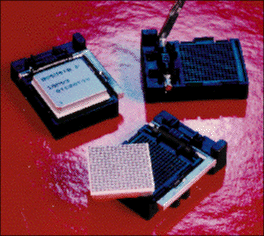
Fig. 1. The Z-Lok line of zero-insertion-force BGA sockets from Wells-CTI
includes a 25-mm size for packages with a 19 x 19 matrix and
a 27-mm size for 20 x 20 parts.
Specifications include an electrical rating of 2 A per contact, capacitance of less than 0.1 pF, and a mutual inductance of less than 1 nH. The Z-Lok sockets cost $0.15 per line in 1,000-piece quantities.
Mill-Max (Oyster Bay, NY) has developed mating BGA adapter and socket modules that convert the BGA to a pluggable device, thus allowing the package to be removed from the socket without damaging the host pc board (see Fig. 2 ). The BGA is soldered to the top of the male adapter, while the mating adapter socket is surface mounted onto the pc board.
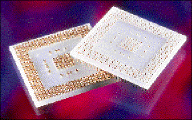
Fig. 2. A mating BGA adapter and socket module
from Mill-Max comprises a male adapter and a
surface-mountable BGA socket.
Both the pluggable BGA adapter and the mating socket have FR4 epoxy insulators that match the thermal coefficient of expansion of the BGA device. The BGA modules have 0.050-in. pin spacing and can be made to accommodate any footprint. The adapter costs $0.135 per pin, and the mating socket costs $0.150 per pin. Both are available 4 weeks ARO.
Methode Electronics (Chicago, IL) has a BGA interface adapter that facilitates the probing and monitoring of all signals on BGAs having up to a 26 x 26 array (see Fig. 3 ). It fans out the normally inaccessible signals to header arrays on 0.050-in. centers.
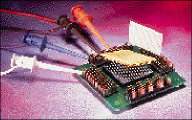
Fig. 3. Methode Electronics' BGA interface
adapter handles BGAs having up to a 26 x 26 array.
Under test, the adapter allows the BGA to function at full operating speeds while signals are monitored. The interface adapter performs with minimum delays and parasitics, and is also designed for use with populated boards. The adapter stands 0.5 in. high, providing a standoff for the headers to clear components on the target board. Price is $800 to $1,000, depending on configuration, with availability 4 weeks ARO.
Ironwood Electronics (St. Paul, MN) now has a low-profile, single-board BGA/BGA package converter. The custom-designed converter has a total height–including solder balls–of 0.085 in.
A typical converter for a 0.050-in. pitch 256-position package reroutes 136 of the BGA's signals on a 10-layer pc board with power and ground planes. It has an adapter-to-board clearance of 0.022 in. and uses tin-lead solder balls and high-temperature FR4 board material. The converter described here costs $179 each in 1,000-piece quantities with a 2-week availability.
Advanced Interconnections (West Warwick, RI) offers its True BGA socket for use in both production and testing. The socket (see Fig. 4 ) allows the BGA to be dropped directly onto mating contacts, and uses a patent-pending, pressure-sensitive retention clamp that easily slides onto the BGA assembly.
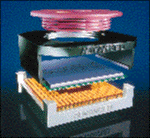
Fig. 4. Designed for both production
and testing, the True BGA socket has
a pressure retention clamp that ensures
reliable package connection.
Offered in a choice of footprints for 96 to 1,296 positions, the socket has an identical footprint to the BGA and a 0.050-in. pitch. It maintains a coplanarity of less than 0.006 in. and comes on tape and reel for automated assembly. A coin-screw or integral finned heat sink is optional. A 357-position socket costs $175 each, with availability 8 to 12 weeks ARO.
Andon Electronics (Lincoln, RI) is making available two-part BGA sockets and adapters with precision-machined terminals. The sockets use insulators made of high-temperature FR4 laminate and have stamped beryllium-copper contacts. The mating adapters have countersunk heads that allow the BGA balls to automatically self-center during mounting.
The sockets and adapt-ers are available in any footprint, as well as in various terminal/socket configurations. They are offered with from 13 x 13 to 32 x 32 positions; other patterns can be provided. In production quantities, a 16 x 16 adapter costs $3.25; the mating socket costs $4.75, with availability stock to 3 weeks ARO.
Pentium and Pentium II
Chupond America (New Hope, PA) has released its Slot 1 connector, which is designed to socket the Intel Pentium II microprocessor. The connector will also accommodate future chips from National Semiconductor and Advanced Micro Devices.
The connector has gold-plated phosphor-bronze terminals and a high-temperature thermoplastic insulator that stands up to reflow soldering. Specifications include a contact rating of 0.5 A per contact, a contact resistance of 30 milliohm, a dielectric withstanding voltage of 500 Vac, and an operating temperature range of –55° to +125°C. In 100-piece quantities, the socket costs $6.40 with an availability of stock to 2 weeks ARO.
Thomas & Betts (Memphis, TN) recently introduced a high-density ZIF socket for the 387-pin Pentium Pro microprocessor. The LAZ Series socket (see Fig. 5 ) has a stainless-steel actuating lever that resists bending or breaking, unlike other actuator mechanisms. The socket's open-frame design provides easy access for component mounting and occupies minimal board space.
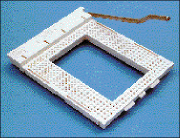
Fig. 5. The LAZ ZIF socket from Thomas & Betts
has a rugged actuating lever and a space-saving open-frame design.
Other features include integral heat sink mounting tabs and V-shaped contacts that provide optimum normal force. The socket is rated for 1 A with an operating temperature range of –55° to +85°C. The price is $5 each in 1,000-piece quantities, with availability stock to 4 weeks ARO.
SOPs and PGAs
For small-outline-packaged devices, Logical Systems (Syracuse, NY) has DIP-to-SO adapters that allow an emulator plug or DIP device to be plugged into a surface-mount prototype (see Fig. 6 ). The adapter's SO-plug, in pin counts from 8 to 28, are soldered onto the circuit board and have a header for the DIP board to plug into.
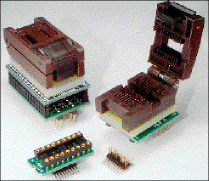
Fig. 6. Logical Systems' small-outline adapters
enable an emulator plug or DIP device to plug
into a surface-mount prototype.
The DIP boards, available in 20 or 28 pins, accept DIP devices or emulator plugs. They are available with or without a ZIF socket. The parts come in a kit with one DIP board and six SO plugs. The adapter kit ranges in price from $46 to $72 with availability from stock. The plugs and boards are also sold separately.
Molex (Lisle, IL) has an expanded line of zero-insertion-force PGA sockets in four models: Socket 8 for Pentium Pro processors, Socket 7 for Pentium 125-MHz and higher processors, Socket 5 for Pentium 90/100-MHz processors, and Socket 3 for 80486 microprocessors. Each socket has a patented single-beam dimple design that provides secure termination retention to the housing.
The sockets are molded of high-temperature liquid-crystal polymer or thermoplastic and have a one-piece cam lever for easy operation. Each socket comes with heat-sink tabs and offers a choice of standoff heights for pc-tail lengths of 2.00, 2.34, and 2.49 mm. A Socket 7 configuration with a 40-µin. gold plating costs $3 each in 100,000-piece quantities, with an availability of 7 weeks ARO.
Century Interconnect Products (Stratford, CT) has a 50-position SOJ socket with 0.80-mm contact spacing. It has a tin-plated nickel base and a UL 94V-0-rated liquid-crystal polymer insulator.
The socket provides an insertion force of 15 oz max per pin, a retention force of 10 oz min, and an extraction force of 1 oz min. Other specifications include a contact rating of 1 A at 200 Vac, a contact resistance of 25 milliohm, and a maximum reflow temperature of 260°C for 10 s. The socket is priced at $0.79 each in 1,000-piece quantities with an availability of 8 weeks.
RF test
For high-frequency testing, Aries Electronics (Frenchtown, NJ) has introduced an enhanced line of RF test sockets (see Fig. 7 ). The sockets provide a signal loss of just 1 dB at 10 GHz.
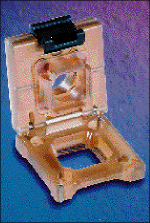
Fig. 7. Aries' RF test socket exhibits
a signal loss of just 1 dB at 10 GHz.
Each socket consists of a contact block, optional lid, and the company's patented Microstrip contact. A compliant-pressure pad, mounted in the lid, squeezes a device onto the contact pins. This squeezing action ensures full compression of the socket's Microstrip contact within a broad range of device tolerances.
Specifications include a self-inductance of under 0.01 nH, a mutual capacitance of 0.04 pF, and an operating temperature range of –55° to +170°C. The sockets are typically just 0.250 in. larger on each side than the device footprint. Pricing for a 64-lead RF contact block is $515, or $858 with the optional lid, with an availability of 4 to 6 weeks ARO.
Quad flatpacks
For quad flatpacks, KEL Connectors (Sunnyvale, CA) now has a JEDEC-qualified QFP socket in 112 or 120 pins. It is made of glass-filled UL 94V-0-rated nylon, and has gold-plated copper-alloy contacts.
Specifications include a current rating of 0.3 A per contact, a contact resistance of 50 milliohm or less, an insulation resistance of 1,000 Megaohm at 250 Vdc, and an operating temperature range of –40° to +120°C. The 112-pin version costs $200; the 120-pin version is $300. Availability is 6 weeks ARO.
Memory modules
Berg Electronics (Etters, PA) recently introduced a 168-position dual-in-line memory module (DIMM) socket which has formed contacts. The formed contacts prevent abrasion when memory modules are inserted and removed from the socket. Price is $0.015 per line in 1,000-piece quantities, with availability 9 weeks ARO.
For more information on the products mentioned in this article, contact the following manufacturers:
Advanced Interconnections
West Warwick, RI
Customer Service 800-424-9850
or 401-823-5200
Fax 401-823-8723
Andon Electronics
Lincoln, RI
John Tate 401-333-0388
Fax 401-333-0287
Aries Electronics
Frenchtown, NJ
Frank Folmsbee 908-996-6841
Berg Electronics
Camp Hill, PA
Customer Service 800-237-2374
or 717-938-7200
Fax 800-237-2374, ext. 7212
Century Interconnect Products
Stratford, CT
Barbara Sheehy 800-221-3576
or 203-375-5344
Fax 203-375-1631
Chupond America
New Hope, PA
Paul Ruo 215-794-9182
Fax 215-794-9183
Ironwood Electronics
St. Paul, MN
Peggy Anderson 612-452-8100
Fax 612-452-8400
KEL Connectors
Sunnyvale, CA
Jack Okawaki 408-720-9044
Fax 408-720-1989
Logical Systems
Syracuse, NY
Lynn Burko 315-478-0722
Fax 315-479-6753
Methode Electronics
Chicago, IL
Jim Kudla 847-392-3500
Fax 847-392-9404
http://www.methode.com
Mill-Max Mfg.
Oyster Bay, NY
Carla Rapacciuolo 516-922-6000, ext. 211
Fax 516-922-9253
Molex
Lisle, IL
Product Information 800-78-MOLEX
or 630-969-4550
Fax 630-969-1352
Thomas & Betts
Memphis, TN
Information 800-344-4744
http://www.tnb.com
Wells-CTI
Phoenix, AZ
Peter Baker 602-581-5330
Fax 602-780-3987
Advertisement





